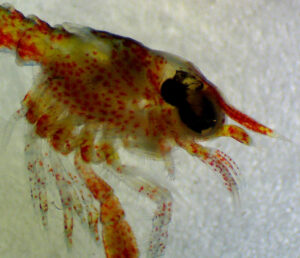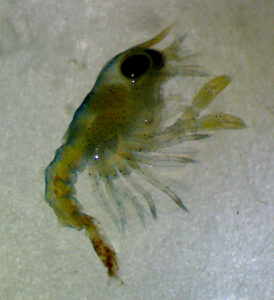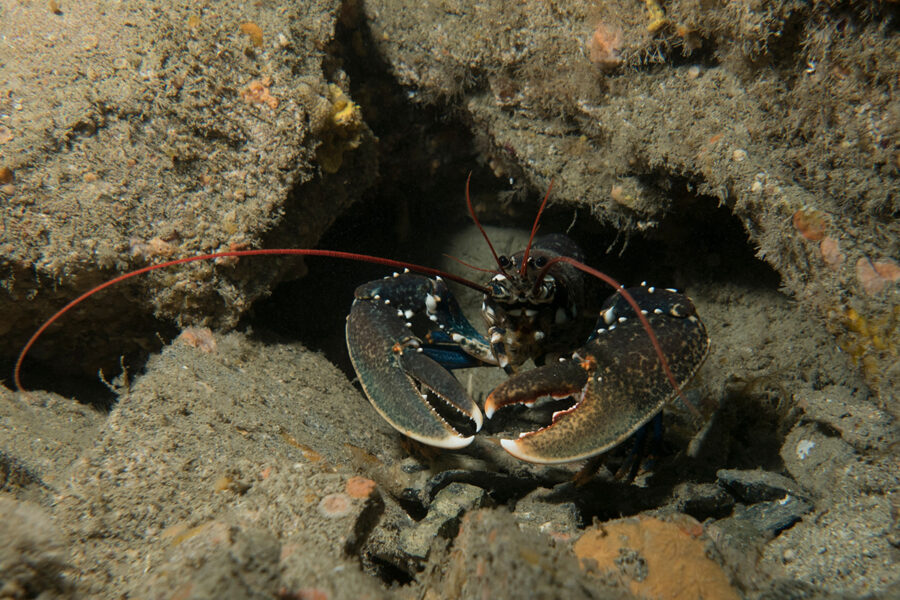A leading fisheries scientist says that in-situ observations are needed before drawing conclusions from a new study which claims that lobster larvae exposed to electromagnetic fields (EMFs), such as those from underwater power cables, develop deformities and swimming problems, reports Paul Scott.
Marine scientists from Heriot-Watt University and St Abbs Marine Station investigated whether cables for offshore wind farms could have unintended effects on commercially important species like crab and lobster.

A healthy lobster larva.
For the research, more than 4,000 lobster and crab eggs were exposed to an equivalent level of electromagnetic field as that experienced near underwater cables. Comparative groups of lobster and crab were not exposed.
The scientists said that their findings reveal that exposed lobsters could not swim as well, and were three times more likely to be deformed in some way, as those in the unexposed groups. Deformities identified included bent and reduced tail sections, disrupted eye development, and puffy or swollen bodies.
However, Mike Roach, fisheries science officer at Holderness Fishing Industry Group (HFIG), said that although the study was ‘well designed’, he had concerns about the translation of the experiment into open-sea conditions.
He told Fishing News: “This is a laboratory-based experiment and the results from such. Translation of these experiments into the natural system should be done with caution.

An exposed larva displays a chromatic aberration eye defect…
“I have no issue with their work, and it aims to take a look at a lot of different, but linked, aspects. My concern is with translating lab work into the wild. In this case, deformities, the headline act, were observed in 3% of the larvae sampled which were exposed to EMF compared to 1% in the control. What does this mean for the natural system when survival from hatch to adult is predicted to be less than 1%?
“Additionally, what is the probability of a berried hen residing next to an exposed cable for the entire brood period? Yes, lobsters have relatively strong site fidelity, but in this experiment, they were in a constant exposure, which is unlikely in the natural system and may only be by a limited number of lobsters due to their aggressive nature.”
For the experiment, the lobster larvae were put through a vertical swimming test to check if they could swim to the surface to find food. The exposed lobsters were found to be almost three times more likely to fail the test, by not reaching the top of the chamber, than the unexposed ones.
In contrast, exposed crab larvae showed no signs of deformity or swimming problems. The scientists described the findings on crabs as ‘reassuring’, but said that longer-term research was needed.

… while another has fused tail segments.
Petra Harsanyi from St Abbs Marine Station said: “Exposure to the EMFs made the crab larvae smaller. While that hasn’t had an immediate effect, it does show that there’s an interference with their development. It would be interesting to monitor this over time to see whether these crabs have long-term impairments or increased mortality.”
The scientists said that the research showed a need for more monitoring of the effects of underwater cables on species like crab and lobster.
Dr Lyndon said: “Lobster isn’t an endangered species, but it is under sustained pressure because of its commercial value.
“We should be aware of the need to shield them from EMFs, particularly during early development, as well as monitoring their long-term behaviour and development, which also goes for crabs.
“One potential solution is to bury the cables in the seafloor. This is already done for many marine renewable developments, but can be expensive and difficult to maintain. It will be important to ensure its continued inclusion in the consenting process for future projects.”
Scottish Renewables, the ‘voice of Scotland’s renewable energy industry’, said that it welcomed the report’s findings on the mitigating factors of burying the power cables.
“Offshore wind developers in Scotland are subject to some of the world’s most stringent environmental requirements, with years of monitoring undertaken before work begins on building an offshore wind farm,” said Morag Watson, director of policy at Scottish Renewables.
“Industry also works closely with regulatory bodies like Marine Scotland and NatureScot when developing plans for new projects.
“Offshore wind developers already bury all cables where possible, often as a condition of their licence, so we welcome this new research as a contribution to those mitigation efforts.
“It is also important to recognise that offshore renewable energy projects provide one of the most powerful tools we have in the fight against one of most widespread threats to the health of the marine environment – climate change.”
HFIG’s Mike Roach said that although the study aimed to address one of the key knowledge gaps around offshore wind farm effects on the environment, more research in the natural system was needed.
“The key message is yes, this piece of work addresses some of the unknown issues surrounding EMFs, but in-situ observations are much needed for this kind of work – more funding is needed!”
The full report was published in the Journal of Marine Science and Engineering and can be read here.
This story was taken from the latest issue of Fishing News. For more up-to-date and in-depth reports on the UK and Irish commercial fishing sector, subscribe to Fishing News here or buy the latest single issue for just £3.30 here.








